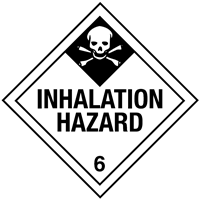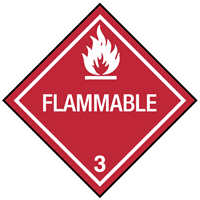Chemical Datasheet
BROMOACETONE |


|
Chemical Identifiers
The
Chemical Identifier fields
include common identification numbers, the
NFPA diamond
U.S. Department of Transportation hazard labels, and a general
description of the chemical. The information in CAMEO Chemicals comes
from a variety of
data sources.
| CAS Number | UN/NA Number | DOT Hazard Label | USCG CHRIS Code |
|---|---|---|---|
|
|
||
| NIOSH Pocket Guide | International Chem Safety Card | ||
| none | |||
NFPA 704
data unavailable
General Description
A clear colorless liquid turning violet on standing, even in the absence of air, and decomposing to a black resinous mass on long standing. Denser than water and poorly soluble in water. Hence sinks in water. A violent lachrymator--low concentrations are very irritating to the eyes; high concentrations or prolonged exposure at lower concentrations may have adverse health effects. Very toxic by inhalation. Contact with the liquid causes painful burns. Used as a chemical war gas.
Hazards
The
Hazard fields
include
special hazard alerts
air and water
reactions, fire hazards, health hazards, a reactivity profile, and
details about
reactive groups assignments
and
potentially incompatible absorbents.
The information in CAMEO Chemicals comes from a variety of
data sources.
Reactivity Alerts
- Highly Flammable
- Air-Reactive
Air & Water Reactions
Highly flammable. Irritating fumes in air. Soluble in water.
Fire Hazard
Special Hazards of Combustion Products: Toxic fumes of Bromine (USCG, 1999)
Health Hazard
Very powerful lachrymator and upper respiratory tract irritant. Intensely irritating to the eyes, nose, throat, and lungs. Corrosive to the skin. (USCG, 1999)
Reactivity Profile
BROMOACETONE decomposes on standing.
Belongs to the Following Reactive Group(s)
Potentially Incompatible Absorbents
No information available.
Response Recommendations
The
Response Recommendation fields
include isolation and evacuation distances, as well as recommendations for
firefighting, non-fire response, protective clothing, and first aid. The
information in CAMEO Chemicals comes from a variety of
data sources.
Isolation and Evacuation
Excerpt from ERG Guide 131 [Flammable Liquids - Toxic]:
IMMEDIATE PRECAUTIONARY MEASURE: Isolate spill or leak area for at least 50 meters (150 feet) in all directions.
SPILL: See ERG Table 1 - Initial Isolation and Protective Action Distances on the UN/NA 1569 datasheet.
FIRE: If tank, rail tank car or highway tank is involved in a fire, ISOLATE for 800 meters (1/2 mile) in all directions; also, consider initial evacuation for 800 meters (1/2 mile) in all directions. (ERG, 2024)
IMMEDIATE PRECAUTIONARY MEASURE: Isolate spill or leak area for at least 50 meters (150 feet) in all directions.
SPILL: See ERG Table 1 - Initial Isolation and Protective Action Distances on the UN/NA 1569 datasheet.
FIRE: If tank, rail tank car or highway tank is involved in a fire, ISOLATE for 800 meters (1/2 mile) in all directions; also, consider initial evacuation for 800 meters (1/2 mile) in all directions. (ERG, 2024)
Firefighting
Excerpt from ERG Guide 131 [Flammable Liquids - Toxic]:
CAUTION: The majority of these products have a very low flash point. Use of water spray when fighting fire may be inefficient. CAUTION: Methanol (UN1230) will burn with an invisible flame. Use an alternate method of detection (thermal camera, broom handle, etc.).
SMALL FIRE: Dry chemical, CO2, water spray or alcohol-resistant foam.
LARGE FIRE: Water spray, fog or alcohol-resistant foam. If it can be done safely, move undamaged containers away from the area around the fire. Dike runoff from fire control for later disposal. Avoid aiming straight or solid streams directly onto the product.
FIRE INVOLVING TANKS, RAIL TANK CARS OR HIGHWAY TANKS: Fight fire from maximum distance or use unmanned master stream devices or monitor nozzles. Cool containers with flooding quantities of water until well after fire is out. Withdraw immediately in case of rising sound from venting safety devices or discoloration of tank. ALWAYS stay away from tanks in direct contact with flames. For massive fire, use unmanned master stream devices or monitor nozzles; if this is impossible, withdraw from area and let fire burn. (ERG, 2024)
CAUTION: The majority of these products have a very low flash point. Use of water spray when fighting fire may be inefficient. CAUTION: Methanol (UN1230) will burn with an invisible flame. Use an alternate method of detection (thermal camera, broom handle, etc.).
SMALL FIRE: Dry chemical, CO2, water spray or alcohol-resistant foam.
LARGE FIRE: Water spray, fog or alcohol-resistant foam. If it can be done safely, move undamaged containers away from the area around the fire. Dike runoff from fire control for later disposal. Avoid aiming straight or solid streams directly onto the product.
FIRE INVOLVING TANKS, RAIL TANK CARS OR HIGHWAY TANKS: Fight fire from maximum distance or use unmanned master stream devices or monitor nozzles. Cool containers with flooding quantities of water until well after fire is out. Withdraw immediately in case of rising sound from venting safety devices or discoloration of tank. ALWAYS stay away from tanks in direct contact with flames. For massive fire, use unmanned master stream devices or monitor nozzles; if this is impossible, withdraw from area and let fire burn. (ERG, 2024)
Non-Fire Response
Excerpt from ERG Guide 131 [Flammable Liquids - Toxic]:
ELIMINATE all ignition sources (no smoking, flares, sparks or flames) from immediate area. All equipment used when handling the product must be grounded. Do not touch or walk through spilled material. Stop leak if you can do it without risk. Prevent entry into waterways, sewers, basements or confined areas. A vapor-suppressing foam may be used to reduce vapors.
SMALL SPILL: Absorb with earth, sand or other non-combustible material and transfer to containers for later disposal. Use clean, non-sparking tools to collect absorbed material.
LARGE SPILL: Dike far ahead of liquid spill for later disposal. Water spray may reduce vapor, but may not prevent ignition in closed spaces. (ERG, 2024)
ELIMINATE all ignition sources (no smoking, flares, sparks or flames) from immediate area. All equipment used when handling the product must be grounded. Do not touch or walk through spilled material. Stop leak if you can do it without risk. Prevent entry into waterways, sewers, basements or confined areas. A vapor-suppressing foam may be used to reduce vapors.
SMALL SPILL: Absorb with earth, sand or other non-combustible material and transfer to containers for later disposal. Use clean, non-sparking tools to collect absorbed material.
LARGE SPILL: Dike far ahead of liquid spill for later disposal. Water spray may reduce vapor, but may not prevent ignition in closed spaces. (ERG, 2024)
Protective Clothing
Self-contained breathing apparatus, chemical-resistant gloves, rubber boots, full protective clothing. (USCG, 1999)
DuPont Tychem® Suit Fabrics
No information available.
First Aid
Call a physician.
EYES: Hold eyelids open, flush with running water for at least 15 minutes.
SKIN: Remove contaminated clothing and shoes, flush affected areas with plenty of water for at least 15 minutes.
INHALATION: Move victim to fresh air. If breathing has stopped, give artificial respiration. If breathing is difficult, give oxygen.
INGESTION: Do nothing except keep victim warm. (USCG, 1999)
EYES: Hold eyelids open, flush with running water for at least 15 minutes.
SKIN: Remove contaminated clothing and shoes, flush affected areas with plenty of water for at least 15 minutes.
INHALATION: Move victim to fresh air. If breathing has stopped, give artificial respiration. If breathing is difficult, give oxygen.
INGESTION: Do nothing except keep victim warm. (USCG, 1999)
Physical Properties
The
Physical Property fields
include properties such as vapor pressure and
boiling point, as well as explosive limits and
toxic exposure thresholds
The information in CAMEO Chemicals comes from a variety of
data sources.
Note: For Vapor Density and Specific Gravity, comparing the value to 1.0 can tell you if the chemical will likely sink/rise in air or sink/float in fresh water (respectively). Short phrases have been added to those values below as an aid. However, make sure to also consider the circumstances of a release. The Vapor Density comparisons are only valid when the gas escaping is at the same temperature as the surrounding air itself. If the chemical is escaping from a container where it was pressurized or refrigerated, it may first escape and behave as a heavy gas and sink in the air (even if it has a Vapor Density value less than 1). Also, the Specific Gravity comparisons are for fresh water (density 1.0 g/mL). If your spill is in salt water (density about 1.027 g/mL), you need to adjust the point of comparison. There are some chemicals that will sink in fresh water and float in salt water.
Note: For Vapor Density and Specific Gravity, comparing the value to 1.0 can tell you if the chemical will likely sink/rise in air or sink/float in fresh water (respectively). Short phrases have been added to those values below as an aid. However, make sure to also consider the circumstances of a release. The Vapor Density comparisons are only valid when the gas escaping is at the same temperature as the surrounding air itself. If the chemical is escaping from a container where it was pressurized or refrigerated, it may first escape and behave as a heavy gas and sink in the air (even if it has a Vapor Density value less than 1). Also, the Specific Gravity comparisons are for fresh water (density 1.0 g/mL). If your spill is in salt water (density about 1.027 g/mL), you need to adjust the point of comparison. There are some chemicals that will sink in fresh water and float in salt water.
| Chemical Formula: |
|
Flash Point:
124°F
(USCG, 1999)
Lower Explosive Limit (LEL): data unavailable
Upper Explosive Limit (UEL): data unavailable
Autoignition Temperature: data unavailable
Melting Point:
-33.7°F
(USCG, 1999)
Vapor Pressure: data unavailable
Vapor Density (Relative to Air): data unavailable
Specific Gravity:
1.634
at 73.4°F
(USCG, 1999)
- Denser than water; will sink
Boiling Point:
277°F
at 760 mmHg
(USCG, 1999)
Molecular Weight:
136.98
(USCG, 1999)
Water Solubility: data unavailable
Ionization Energy/Potential: data unavailable
IDLH: data unavailable
AEGLs (Acute Exposure Guideline Levels)
| Exposure Period | AEGL-1 | AEGL-2 | AEGL-3 |
|---|---|---|---|
| 10 minutes | 0.011 ppm | 1.4 ppm | 4.1 ppm |
| 30 minutes | 0.011 ppm | 0.57 ppm | 1.7 ppm |
| 60 minutes | 0.011 ppm | 0.33 ppm | 0.98 ppm |
| 4 hours | 0.011 ppm | 0.11 ppm | 0.32 ppm |
| 8 hours | 0.011 ppm | 0.063 ppm | 0.19 ppm |
(NAC/NRC, 2024)
ERPGs (Emergency Response Planning Guidelines)
No ERPG information available.PACs (Protective Action Criteria)
| Chemical | PAC-1 | PAC-2 | PAC-3 |
|---|---|---|---|
| Bromoacetone (598-31-2) | 0.011 ppm | 0.33 ppm | 0.98 ppm |
(DOE, 2024)
Regulatory Information
The
Regulatory Information fields
include information from
the U.S. Environmental Protection Agency's Title III Consolidated List of
Lists,
the U.S. Cybersecurity and Infrastructure Security Agency's Chemical Facility
Anti-Terrorism Standards,
and the U.S. Occupational Safety and Health Administration's
Process Safety Management of Highly Hazardous Chemicals Standard List
(see more about these
data sources).
EPA Consolidated List of Lists
| Regulatory Name | CAS Number/ 313 Category Code |
EPCRA 302 EHS TPQ |
EPCRA 304 EHS RQ |
CERCLA RQ | EPCRA 313 TRI |
RCRA Code |
CAA 112(r) RMP TQ |
|---|---|---|---|---|---|---|---|
| Bromoacetone | 598-31-2 | 1000 pounds | P017 |
(EPA List of Lists, 2024)
CISA Chemical Facility Anti-Terrorism Standards (CFATS)
No regulatory information available.OSHA Process Safety Management (PSM) Standard List
No regulatory information available.Alternate Chemical Names
This section provides a listing of alternate names for this chemical,
including trade names and synonyms.
- ACETONYL BROMIDE
- ACETYLMETHYL BROMIDE
- ALPHA-BROMOACETONE
- ALPHA-BROMOPROPANONE
- BROMO-2-PROPANONE
- 1-BROMO-2-PROPANONE
- BROMOACETONE
- BROMOACETONE, [LIQUID]
- 1-BROMOACETONE
- BROMOMETHYL METHYL KETONE
- MONOBROMOACETONE
- 2-PROPANONE, BROMO-




